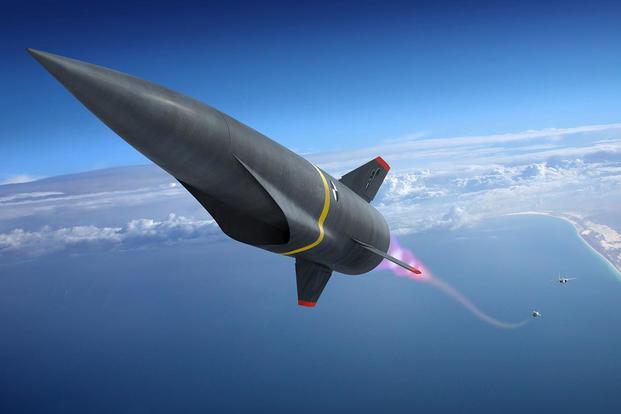Boost-glide hypersonic weapons have a longer range. Air-breathing cruise missiles are smaller and configurable for a wider range of platforms, such as bombers or fifth-generation fighters. The Pentagon is looking for a complementary mix of both as it pursues new hypersonic technologies for its arsenal, according to top officials.
"At this point, we don't want to see an either/or; we actually want to see both technologies pursued," said Mark Lewis, the Defense Department's director of defense research and engineering for modernization.
Lewis and Mike White, the assistant director of defense research and engineering for modernization, briefed reporters at the Pentagon on Monday.
The Pentagon wants to develop more "air-breathing hypersonic cruise missile configurations," White said.
As noted by Aviation Week, interest in scramjet propulsion systems -- short for supersonic-combustion ramjet technologies, which use a jet engine that compresses incoming air -- has seen a comeback since 2016, when the Defense Department prioritized boost-glide hypersonic tech instead.
Related: Navy Sets Date for Crucial Hypersonic Weapons Flight Test
For example, the Air Force recently chose to advance its Air-Launched Rapid Response Weapon (ARRW, pronounced "Arrow") program, which leverages efforts from the Defense Advanced Research Project Agency's (DARPA) Tactical Boost Glide project. Last month, it canceled its Hypersonic Conventional Strike Weapon, known as HCSW (pronounced "Hacksaw"), in order to shift resources to ARRW. Both prototypes are designed by Lockheed Martin Corp.
But White said there is now opportunity for the Air Force to work more closely with DARPA on the Hypersonic Air-breathing Weapon Concept, known as HAWC; the Pentagon could even establish follow-on weapons from discoveries made through the HAWC program, he said.
"One of the side benefits of the Air Force stepping away from HCSW and putting a bow on it at [the critical design review stage] is now they can focus on the air-breathing transition as a second potential hypersonic transition opportunity [to HAWC]," White said.
"We're also looking at some other configurations with a broader range of capabilities," he added, but did not provide additional details on potential weapons prototypes.
The Pentagon has worked steadily to create hypersonic weapons, which move at more than five times the speed of sound and can act as deterrents -- even game changers -- when responding to conflict from hundreds of miles away.
The officials said the services are working closely together on prototyping efforts, especially as the Pentagon is on a mission to upgrade both its offensive and defensive capabilities.
"I don't know of any other part of the modernization portfolio where I see such close coordination between the services and the agencies," Lewis said, noting the Pentagon's quest for multi-domain weapons spanning air, land and sea.
"Hypersonics isn't a single thing. It's a range of capabilities," he said. "It's intermediate-range. It's long-range. It's things coming off of ships. It's things coming off of trucks. It's things coming off the wings of airplanes and out of bomb bays."
-- Oriana Pawlyk can be reached at oriana.pawlyk@military.com. Follow her on Twitter at @Oriana0214.
Read more: Army and Marines to Arm Snipers with Special Operations Multi-Caliber Sniper Rifle












